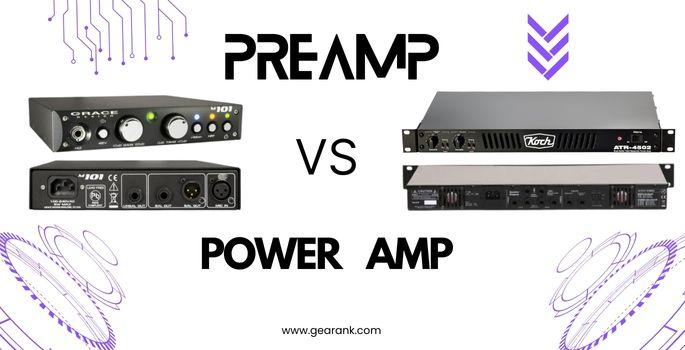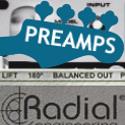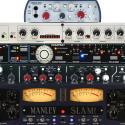Preamp Vs Power Amp: A Clear Explanation

On the surface, preamp vs power amp may seem similar, but fundamental differences exist.
The preamp and the power amplifier both take an electrical signal and add gain, but they apply it differently. While they perform similar tasks, they have distinct roles in a signal chain.
The preamp adds initial gain, transforming weak signals to line level signals while building tone. Then the power amp boosts this signal again before it reaches the speakers.
Preamps and power amplifiers are found in various types of audio equipment. Often times they are included in one device like a guitar amplifer, but they are also available as standalone units.
If you're new to recording and playing music and you're ready to learn more about amplifiers, check out this guide. Learn what separates the preamp section from the power amp section.
What Are Preamps?
The preamp is the first piece in the signal amplification chain of your audio equipment. A preamp takes the output signal from your instrument, adds gain to give it some voice, and transforms the signal so it can be processed. The signal can then move forward through the amplifier.
At a basic level, a preamp takes a low-level signal and boosts it to line level. When a low-level signal comes into the amp, it tends to be around 4 dBu. It needs around 30 dB gain to become a line level signal. The signal can be boosted by the power amp to the speaker level from the line level. Note that line level is different from instrument level.
Mic preamps operate on this principle. Their design ensures that no distortion occurs at proper gain levels.
Electric and acoustic guitar preamps are different. If you don't have any pedals, the preamp is the first thing your guitar signal reaches. At this point, the signal is quiet and weak. Plug a guitar directly into an audio interface, and you'll hear how thin it is.
But once the signal has passed through the preamp, it has gain. The signal will now be louder and bolder.
The preamp will also distort and compress your signal if you add enough gain. Compression ensures a more consistent sound, but in this case, it's a byproduct of the Audio Clipping process.
There are various controls leading to the preamp. You can expect to find numerous controls for the preamp, including master volume and gain. EQ controls are also linked to the preamp -- expect to find bass and treble controls.
What Is Preamp Distortion?
It is an artifact from the amplification process, usually occurring when you push the gain enough to clip gain stages. For mic preamps, clipping is often avoided unless it's for stylistic reasons. For guitar amps, clipping and overdrive is often a desired characteristic.
Modern amplifiers typically add distortion during the preamp phase. Distortion from the preamp tends to sound compressed and saturated. However, the exact level of distortion will depend on the type of amplifier you're using.
The valves (tube) or transistors (solid-state) in the preamp are designed for high gain, making them sensitive to volume. They often have enough gain to compress or even clip the signal.
If you don't think your preamp is achieving the desired level of distortion, have a play with the controls. Turn the master volume control down and the gain control up. Any distortion you hear will be coming from the preamp. When it comes to distortion and overdrive, most prefer the natural clipping of a tube preamp.
Preamp Pedals
Preamp pedals have been built to last longer than a standard rig and offer impressive reliability. They're also much lighter and easier to travel with than your typical rig. For gigging musicians, there are apparent benefits to pedals over guitar amps.
Because of the limited size of a pedal, most are solid state preamps. But there are some that utilize genuine tube preamps.
While basic preamp pedals are available, affordable varieties can offer excellent control. These pedals have multiple channels for different sounds, allowing guitarists to work with unique effects. Expensive pedals will provide even more controls and signal routing options. They allow for more tweaking, and some even have effects loop in and out. You have room to perfect your sound.
Currently, preamp pedals are at a different level than the standard rig. However, the market is evolving in some exciting directions.
What Are Power Amps?
Power amps come into play at the end of the amplification chain. It continues the job of the preamp, adding extra gain before the speakers. A power amp takes a line level signal and makes it speaker level.
The power amp does a very similar job to the preamp. Technically, they do the same job. Both amplifiers push the signal level higher before it comes out of the speaker.
However, the two amps are kept separate for a good reason. The boost of the power amp transformers can lead to high temperatures and excess floor noise. This isn't good for the preamp and can affect the sound quality.
What Is Power Amp Distortion?
As mentioned previously, any form of distortion for microphones and other instruments can be undesirable. However, guitars sound great with distortion. If preamp distortion is a heavy punch, power amp distortion is the knock-out blow. You need to turn up the volume to hear power amp distortion. But at top volume, the tone can sound punchy and powerful.
Power amp distortion depends on the type of valves used in the amp. EL34 and El84 valves are found in British brands such as Marshall. They distort easily, creating a compressed sound at a lower volume.
On the other hand, brands like Fender prefer to use 6L6 or 6V6 valves. These need to be pushed before they start to distort. You'll get a cleaner sound at a higher volume.
Doom Metal and Stoner Metal bands have created a sound based on this distortion. It's more loose and gurgly sounding than preamp distortion. For a common example, check out classic bands like Black Sabbath or modern bands like Sleep or Queens of the Stone Age.
Power Amp Pedals
You can also get the power amp in pedal form, like the preamp. Again, these pedals allow you to streamline your rig. Power amp pedals also connect your effects pedals to a guitar cabinet.
Power amp pedals are generally designed for use alongside preamp pedals. This recreates the traditional amp setup in a smaller package.
However, you can use power amps with overdrive, distortion pedals, and multi-effects units. This allows you to remove the preamp entirely and create a unique sound.
Examples of a power amp in pedal format is the Electro-Harmonix 44 Magnum Power Amplifier.
What's The Difference Between A Preamp vs Power Amp?
The primary difference between a preamp and a power amp is where they're found in the chain. Beyond that, they perform a similar function. Both are stages in amplification, boosting the gain of a signal before it reaches the speakers.
A preamp is found at the start of the chain, while the power amp is at the end. The signal will hit the preamp before the power amp as the signal travels through the system.
Along that journey, the signal might come across various effects. The chain the signal follows will sometimes be complicated. However, no matter how complex the process, it's standard for the preamp to be near the start and the power amp at the end.
The preamp is at the start because it's taking a low signal and making it line level. This initial phase will also add distortion. The preamp can play with the signal at this early stage.
Preamps are more complicated than power amps, with greater versatility. You can play with the tones at the preamp, shaping your final sound.
When the signal reaches the power amp, it's almost ready to be heard. Very little will happen to the signal between the power amp and the speaker. The power amp boosts the electrical signal one final time.
Do I Need Both A Preamp And Power Amp?
Yes, you do need both a preamp and a power amp! They might accomplish relatively similar aims, but they both perform unique functions. And they need to be separated to prevent the heat of a power amp from damaging the preamp.
A preamp transforms a low-level signal to a line level signal. This requires a manageable amount of power. Because the preamp lacks that power, a weaker signal can't drive the speaker.
A power amp has the power to drive a speaker. However, it needs a line level signal to do so. Straight from the guitar, the signal is too weak for the power amplifier.
Preamps also add tone and distortion. Add this low level; it's easier to build a unique sound. You have more options to play with. You'd lose this if the signal went straight to the power amp.
Preamp And Power Amp In Instrument Amplifiers
A standard instrument amplifier (like a guitar amp) will contain both a preamp and a power amp. In this case, the preamp tends to encompass the EQ and the signal boost. The preamp will be primarily responsible for the shape of the sound.
Despite the added responsibility of the preamp, the two amplifiers remain in the same place in the chain.
Preamp And Power Amp In Home Recording Studios
They are highly important, but preamps and power amps are only some of your first considerations when designing a home studio. While you do need both amplifiers, they aren't a key purchase. This is because you already own them.
Preamps can be found installed in audio interfaces. Connecting to the DAW, the audio interface is essential for capturing sound. This is a basic preamp, but it gets the job done.
For more control over your sound, consider an external preamp. It isn't essential, but it can give you greater tone control.
As for power amplifiers, they're built into active studio monitors. You don't need to purchase a power amp separately if there's one in your active studio monitor. Adding a preliminary power amp can damage the system.
Preamp And Power Amp In Home Stereo Systems
Many home stereo systems come with both preamps and power amps. These all-in-one designs are easy to use and streamlined. However, they aren't hugely adaptable.
A mix-and-match system gives you greater control over your sound. You can build a system that works for you and your music. If you assemble components, you must buy a preamp and a power amp.
Even in these modular systems, preamps and power amps occupy the same places in the chain. A preamp will be placed early in the chain, generally after the initial sound source. The power amp will be placed just before the speakers.
What About The Speaker Cab?
Combining a preamp, power amp, and speaker cab creates an instrument amplifier. The speaker cab houses the different amplifiers, allowing you to manipulate the tonality of the output signals. The speaker cab helps project the audio signal so that we can hear and enjoy it.
Frequently Asked Questions
Why Separate Preamp And Power Amp?
Although a preamp and a power amp accomplish similar goals, they are kept separate in an audio system. The boost needed from a power amp can interfere with the preamp signal. It can also introduce excess heat, potentially leading to damage.
Is Preamp More Important Than Power Amp?
The preamp and the power amp are essential for creating an enjoyable sound. The preamp does a little more, as preamps will sometimes encompass EQ, but you still need the power amp. There is no winner in preamp vs power amp -- they have to work together!
Conclusion
Both the preamp and power amplifier boost an electric signal from an instrument to play through a speaker. The preamp receives the signal early in the chain, adding distortion. The power amplifier gets the signal and boosts it for the speaker.
The two work separately to achieve the same goal. The weak initial sound has depth and power, having passed through both sets of valves. It's ready to be heard and enjoyed.
I hope this guide has helped you understand preamp vs power amp and why you need them both.












